10 November 2021 UPDATE: Find my updated brush guide HERE!
Brushes! What a HUGE topic! I put off writing this post for a looooooooong time because I felt like I didn’t know enough to have an informed opinion. I’m still no expert, but friends keep asking me about what brushes I use, so here we are haha! :)
THIS is the post about watercolor brushes I wish I could have found somewhere when I was getting started all those years ago.
I tried to pack in as much info in here as I could for you — so here’s the gist in a nutshell:
- Each person is different and what works for me may not work for you. I think you owe it to yourself to try the same size brush across synthetics and real sable in a few different brands so you can see what you like.
- I recommend Winsor & Newton Sceptre Gold II’s if you’re just starting out. They’re a blend of sable and synthetic and they almost compare to the real deal. Almost.
- My unicorn brushes are Isabey 6223/6201 series and the Escoda Reserva line. These are real sable and almost identical.
Read on for more!
Things to Consider
So before we dive into the actual brushes I thought I’d start out with The Questions I ask myself when I try a new brush now — and the urge is still there to try new ones, even though I think I’ve finally found my magic wand — I think we’re all a bit like that, right?
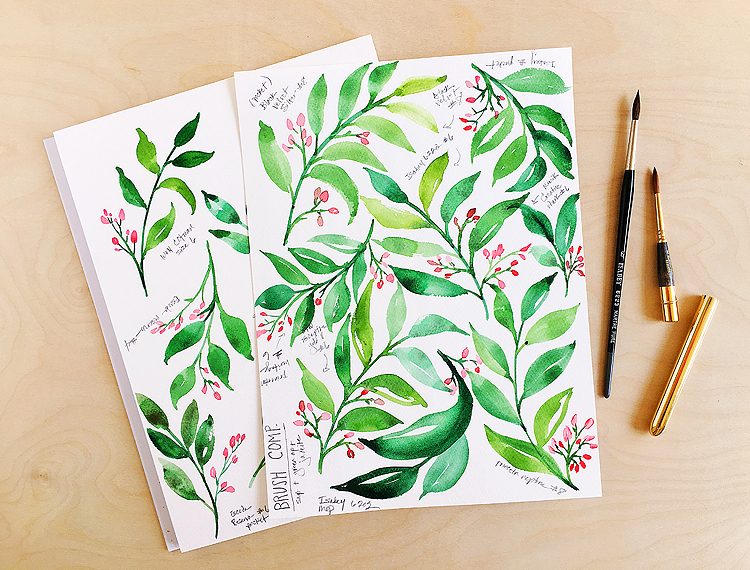
I don’t recall where I read someone comparing a brush to a magic wand but it’s so true! Each person is unique and what works for me may not work for you. If you’re just starting out I’d try 2-3 brands all in the same size to see what you like.
The Questions:
- What media are you primarily working with? Watercolor, acrylic, gouache, ink?
- Where will you be using the brush? Studio or out in the wild? If you’re sketching in the wild, how will you carry the brushes around? Also what will you use for water?
- What size painting will you be working on?
- What kind of paper will you be working with? (Paper is a whole other post that I plan to write soon!)
- What is the your main subject matter? Flowers? Sky? Clouds? Buildings? or All The Things!
- What price point do you want? I’ve found that price doesn’t always equal how well I’ll love a brush.
- Do you have ethical considerations/want to stick to synthetic brushes?
So many questions, right?
I mostly work in watercolor so that’s what this post will cover, although I’ll throw in some tips for other media as well.
Size Matters
:)
Seriously, tho, size really does matter! I’ve come to learn to use the biggest brush for the job — it holds more paint or water for longer so you’ll have more space to play before you run out.
I mostly work in a sketchbook on 5. x 8.25″ pages and I use sizes 6 and 8 rounds and then a size 2 or 4 for adding details. My biggest brush is a size 30 synthetic and I love to use it on 9×12″ paper and up. When trying new brushes, I generally try out a size 6 since that’s what I use the most.
Also, I just wanted to mention that size isn’t consistent across manufacturers — so a Winsor & Newton size 6 and an Isabey size 6 could be totally different. Another thing to consider is the brush shape — if a brush has a fuller belly it can hold more pigment and work almost the same as a larger brush.
My Magic Wands
It took me several years of experimenting, but I found that sable brushes work best for me for what I usually watercolor — which is mostly wildflowers, leaves and little landscapes in my sketchbook.
Here’s what I love about sable:
- Sable glides across the page, releasing water/paint smoothly. Some synthetic brushes tend to drop all of their paint as soon as they touch the paper.
- Sable has that sweet spot of being springy without being tooo springy or stiff and they’re soft without being too soft and mushy feeling (I sound like Goldilocks and the Three Bears here haha!)
- These brushes have amazing points!
What I don’t love? The price! haha! These brushes are a little pricey, but luckily since I mostly work in a sketchbook I don’t need big brushes for these.
So big drumroll…here are my unicorn brushes:
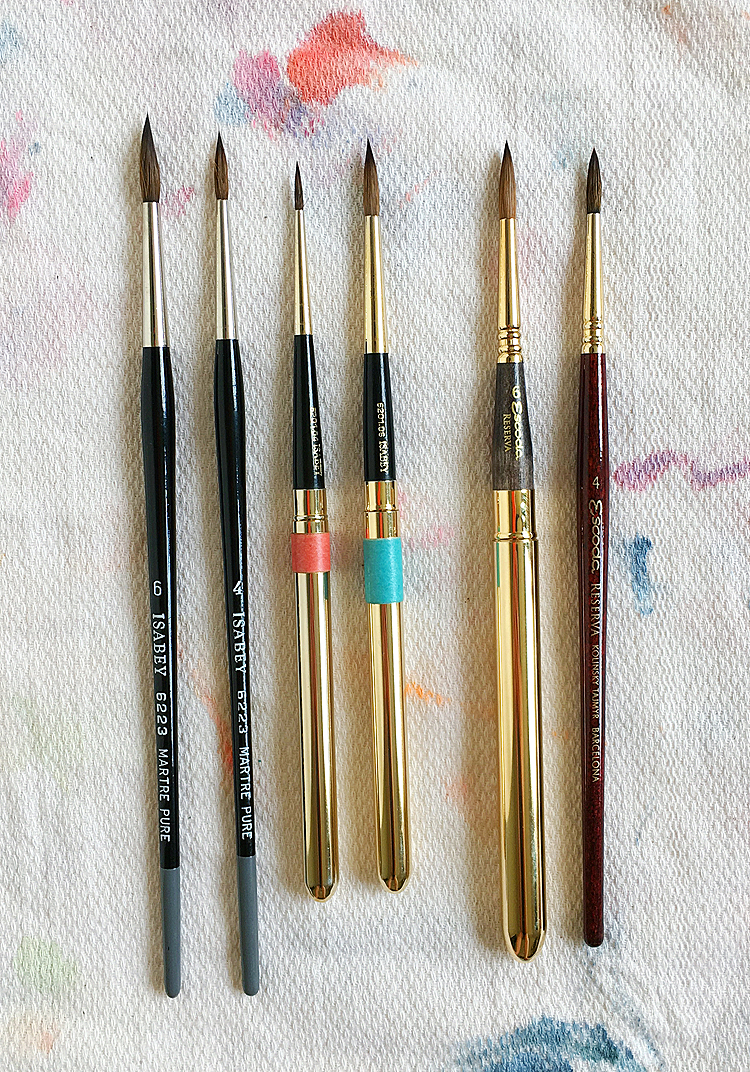
- Isabey 6201 series (pocket) and 6223 (regular) sable — I have these in both the pocket brushes with the cap and regular brushes and use them almost everyday! Note that regular brushes are sometimes less expensive if you don’t have a need for the pocket version. They have such nice points, hold a ton of paint and really glide across the paper. If I was on a desert island and could only have one brush it would be the Isabey 6201 pocket size 6. In fact, the points are so good that you can get away with not having a brush for details. These brushes are handmade in France, oooo la la!
- Escoda Reserva sable in both pocket and regular versions — these are on par with the Isabey — love! And they’re handmade in Spain. One thing to note, the cap/handle for the pocket version is much thicker and larger than the Isabey if that matters to you. I’ve been using this at my desk since it doesn’t fit as well in my field bag.
Here’s a super closeup of the Isabey and Escoda brushes, all in size 6 for comparison — as you can see the Isabey 6201 and the Escoda Reservas are almost identical, although the Isabey 6223 has a fuller belly and longer point. And those points! Ahhhhhhhh!
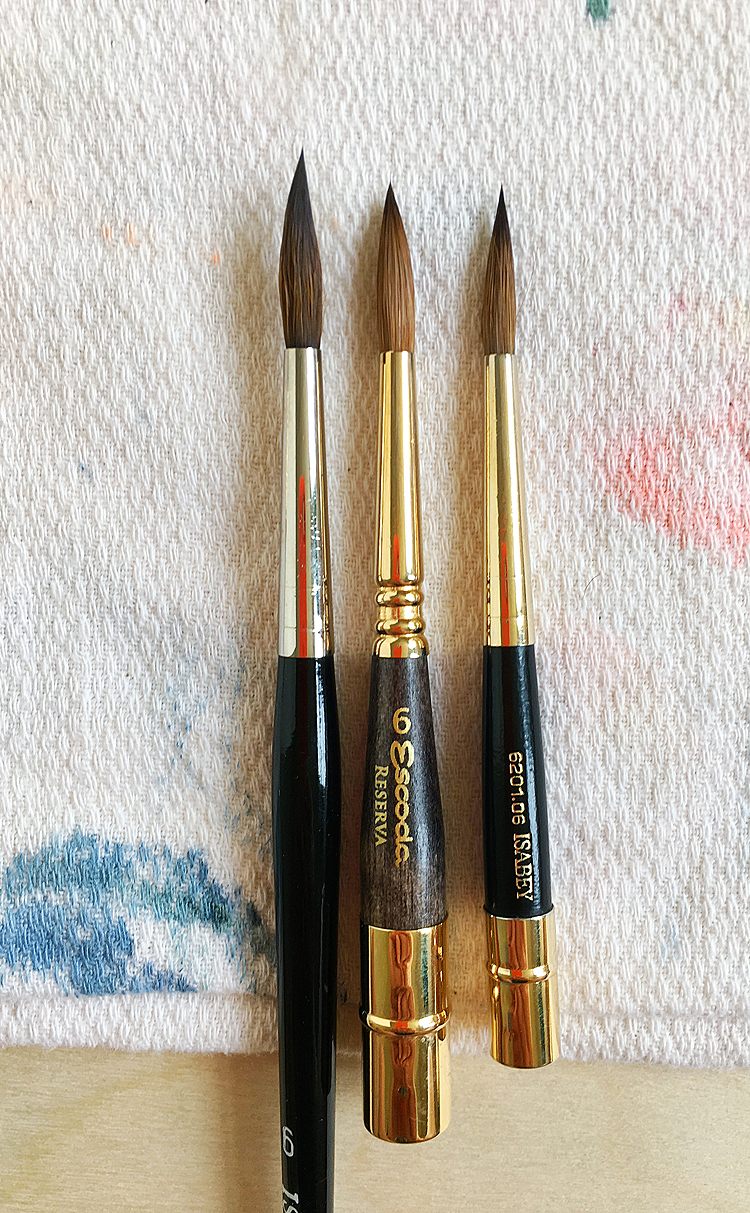
I’ve used that Isabey size 6 pocket brush on the right almost everyday for two years now and it still has an awesome point! Also, the belly of the Isabey 6223 regular size 6 brush is a little bigger than the Isabey 6201 pocket brush and the Escoda Reserva.
One thing I’ve learned about sable brushes — sometimes they dry all fluffy and kinda poof out, but as soon as you dip them in water and shake them off they’ll return to a fine point. I wet these brushes in water before taking their portraits — I wanted them to look their best for you!
As for the pocket brushes, I’ve found that it’s best to put the cap on while the brush is wet so that you don’t catch any stray hairs and then if you live in a humid climate take the caps off when you return home. The caps do have a hole in the end so the brushes will get some air. Here in Central Texas I usually just leave the lids on after I’ve been out sketching and haven’t had a problem.
Also I wanted to mention that brush handles vary across manufacturers as well and that might be something for you to consider.
- The pocket brushes are heavier than their wooden handle counterparts, with the Escodas being the heaviest.
- The Escoda wood handles are also thicker than the Isabeys.
- The Isabey 6223 wood handles are narrower than all the other brushes that I own and took a bit of getting used to, but now I love it — I use it as a reminder not to grip the brush too hard and let it do it’s thing.
Now for my other workhorse brushes — I use these all the time, just don’t reach for them as often as the sables. I also tend to use these for grittier paints and gouache:
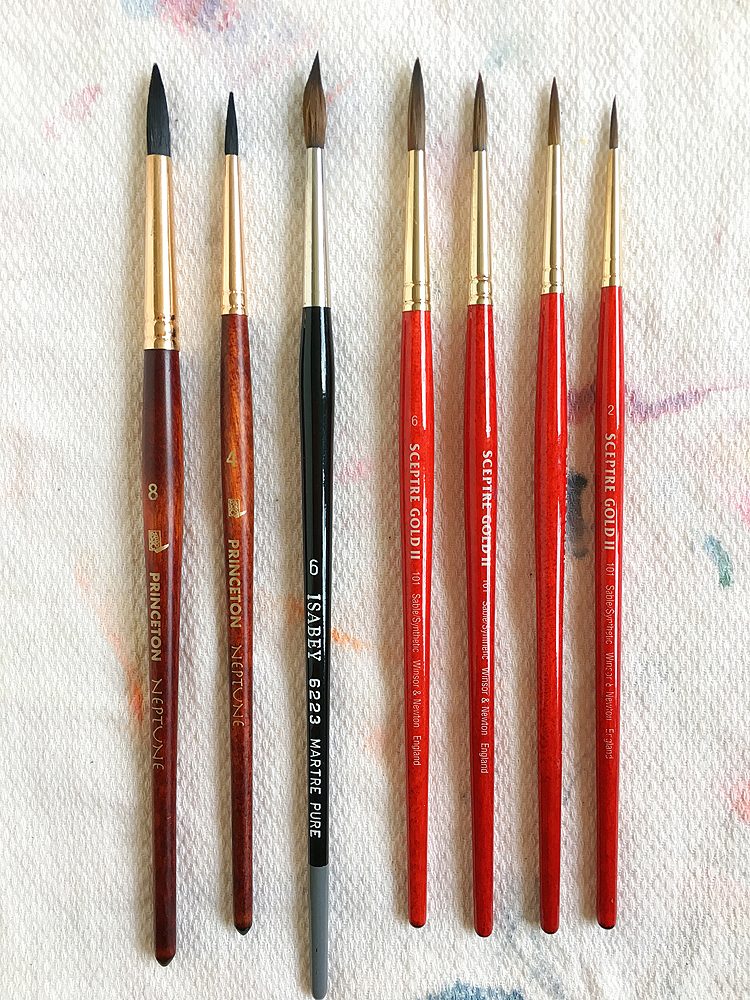
- Winsor & Newton Sceptre Gold II series 101 sable/synthetic blend — these are less expensive compared to the pure sables and work almost as well! They don’t have the same holding capacity and they don’t come to as quite as fine of a point, but they’re still really great brushes. If you’re just starting out in watercolor I’d put these on my list to try for sure! I use the size 2 all the time for applying Dr. PH Martin’s Bleed Proof white.
- Princeton Neptune – I love these for stems and big juicy florals, although I wouldn’t try to do detailed paintings with them because I find the points too soft for that, plus the way they release paint/water can be harder to control. When I’m working on florals sometimes I use the Neptunes for the stem, petals and leaves and then add details with the Isabey or Escoda sable brushes. I have a size 8 that I cut the handle off of so that it would fit in my sketch kit — all because I like using it for stems haha!
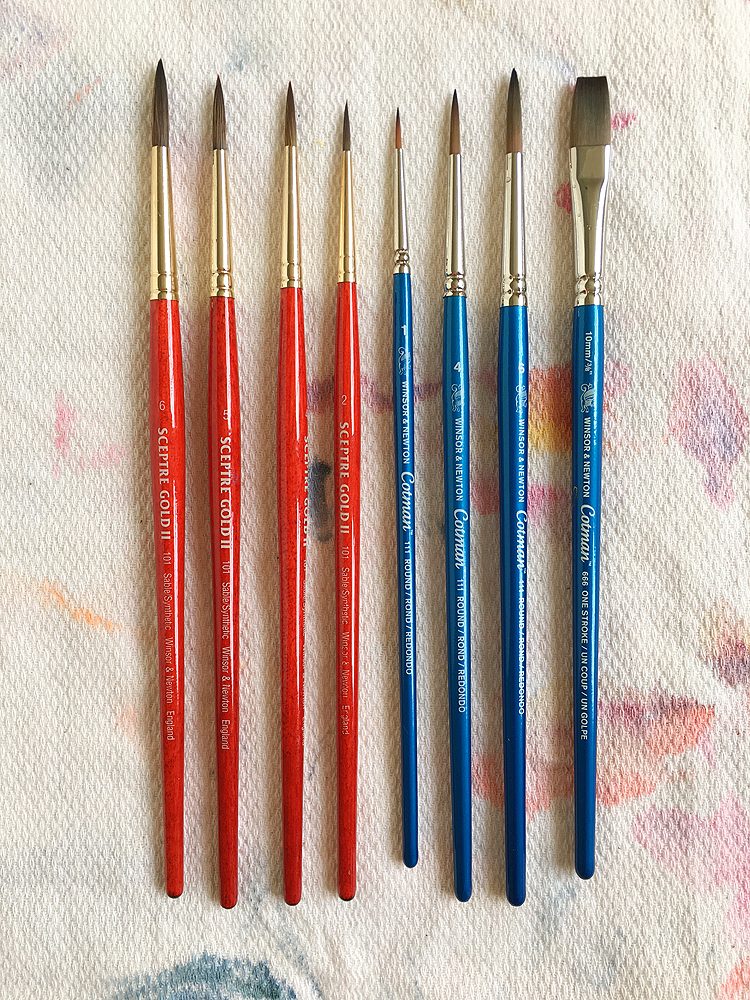
For gouache or gritty watercolor paints:
- Winsor & Newton Sceptre Gold II sable/synthetic blend again
- Winsor & Newton Cotman brushes — the Cotman brushes are great brushes for the money! They aren’t quite on the same level as the Sceptre Gold tho — they feel a little stiffer and don’t have the same carrying capacity.
I also use these for student grade paints since they contain more fillers and are harder on your brushes. I really baby my unicorn sable brushes! :)
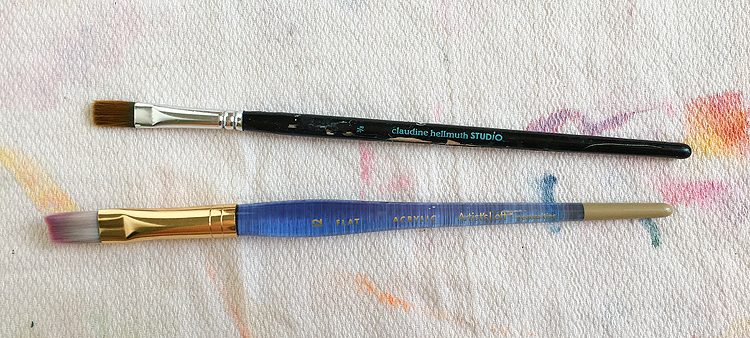
Recently I’ve been trying to get better at painting clouds and skies in my sketchbook, and I discovered that cheap white synthetic brushes are AWESOME for clouds. I think it’s because they’re so soft that they really glide across the paper and move the pigment around without causing the paper to pill. I got this brush in a big pack at the craft store and tried it on a whim after watching some of Peter Sheeler’s excellent video tutorials.
I also have a really old flat brush meant for acrylic paint that I use for scrubbing/lifting paint.
Second String
These brushes are still in rotation and I use them for specific things, but they’re not my go-to brushes.
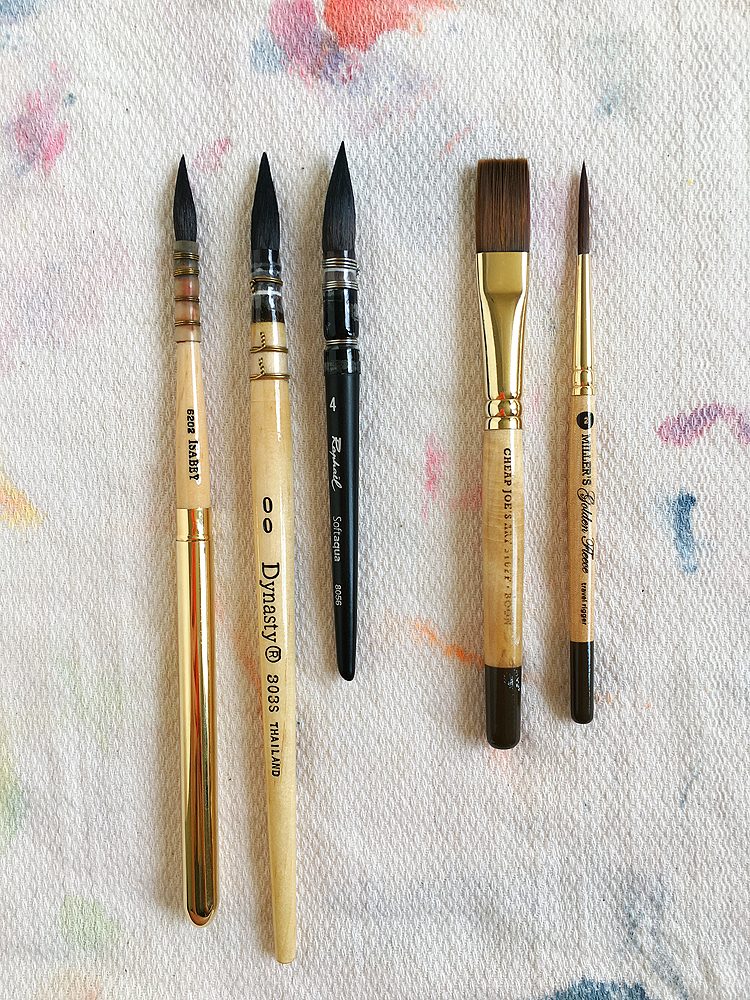
- Mop brushes — the Isabey pocket mop, Dynasty and Raphael — I use these when painting large areas and have been playing around with them for skies. Still haven’t quite gotten the hang of them yet tho. The Isabey pocket mop is a beautiful brush and behaves well, but it’s on the small side and I end up using a Princeton Neptune instead. The Raphael holds a ton of paint but it tends to make my sketchbook pages warp and take forever to dry — which is problematic when I’m out in the field.
- Cheap Joe’s Golden Fleece — I got the travel size of these thinking that they’d be easy to carry around and while I do like them in general, I don’t really care for how they work with the paper in my sketchbook. I think it’s because the sketchbook paper has a lot of sizing in it and these brushes are so stiff they almost lift the paint from the paper while you’re painting it.
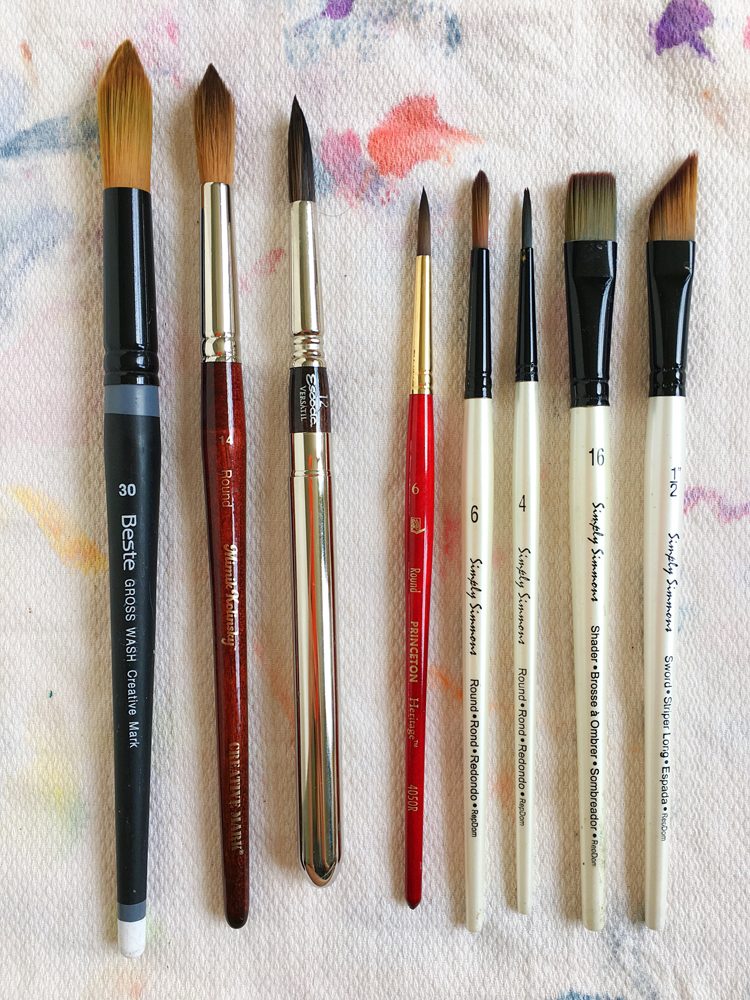
- The Big Guys — I love playing with this Creative Mark Beste size 30 and Mimik Kolinsky size 14! They’re a little big for me and I don’t use them everyday or in my sketchbooks but they are super fun to play with! Creative Mark is Jerry’s Artarama brand and you’ll only find them there. We have a Jerry’s here in Austin — so dangerous going there. :)
- Escoda Versatil — I got this size 12 to see how the Escoda Versatil synthetic sable line compared to the real sable/Reservas and it’s a little stiff for me and these don’t come to as fine of a point — they’re still fun to play with tho! Much less expensive than the Reserva.
- Princeton Heritage – these are pretty similar in shape and size to Winsor & Newton Sceptre Gold II but I’ve found that I get more unintentional blooms and back-runs with them. They’re great for gouache tho.
- Simply Simmons — Lindsay Stripling uses these all the time and I love her work so much! They just don’t work for watercolors for me, although I do use them for acrylics.
Looking at this list, all of these brushes are on the stiffer side and don’t have much movement — maybe that’s why I’ve grouped them together. Hmmmm…
I also feel like they don’t hold as much paint and I’m more prone to getting unintentional blooms when I use them.
Still Want to Try
- A big juicy mop or quill brush! I’d love to try one of these for painting skies. If you have a suggestion on these I’d love to hear. I’ve had my eye on the Escoda Aquario’s for a while now but haven’t been able to pull the trigger.
- Winsor & Newton series 7 sable — I hear such good things about these! I suspect that they’re pretty similar to the Isabey 6223 and Escoda Reserva lines.
- Rosemary & Co pocket brushes — ditto, keep hearing amazing things about them, plus they have different brush shapes available in pocket versions.
- Escoda Perla — these are intriguing to me because they’re made of white synthetic — so I’m wondering how they’d do for clouds and skies. Thinking that a pocket version could replace my cheap one from the craft store in my backpack :)
I’m noticing a theme here on the clouds and skies LOL!
#BrushFail
These brushes just don’t do it for me…sorry, brushes!

- Silver Black Velvet – there are so many amazing artists out there who uses these brushes with great results — sadly, I’m not one of them. I don’t care for how they hold water and then release it on the paper. Just doesn’t feel good to me, like they’re kinda mushy? Hard to describe! In my opinion they’re kinda like a misbehaving Princeton Neptune hahah! Check out my friends Sandy Allnock and Lydia Fiedler for what you can do with them. Also, I own both the travel and regular brushes in size 8 — anyone want to trade? :)
- Water brushes — of all brands! I’ve come to realize that I just don’t like how they behave and how they seem to fade pigment. Now that I’m using better paints it’s especially noticeable. Sure they’re more convenient, but I’d rather carry around a little jar of water than use one of these guys. :-P I do use them for going over water soluble ink when I’m doing a quick pen + ink sketch, but that’s about it.
Brush Care
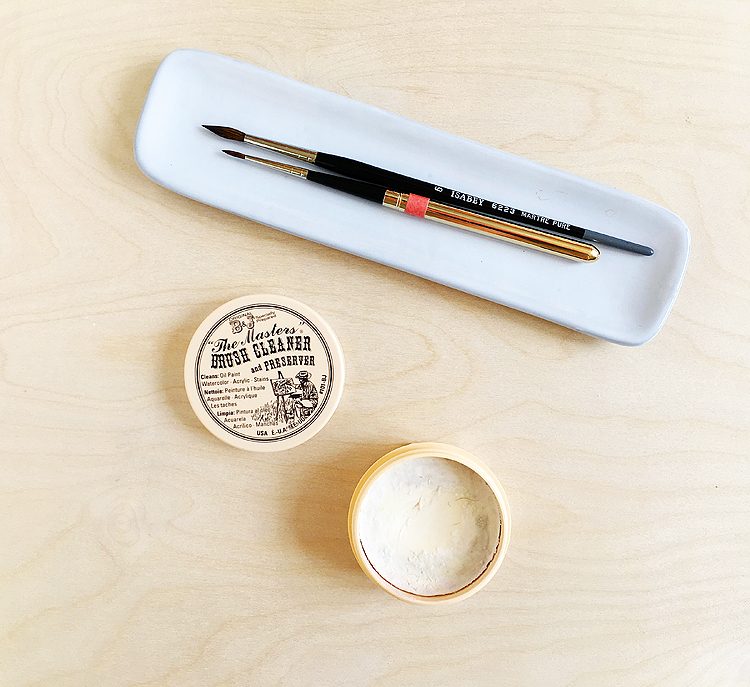
Before I go I thought I’d add a few things I’ve learned about brush care:
- First off, I no longer leave my brushes sitting in a jar of water :) I cringe when I see other people do it now ha! I ruined too many brushes this way — luckily they weren’t expensive ones.
- I have a ceramic dish/plate thing on my desk and I’ve gotten into the habit of throwing the brush in there after I rinse it out — this way the bristles don’t get messed up and it can dry flat without water running back into the ferrel. The dish was originally intended for holding olives like at a fancy dinner party. Since I don’t host many fancy dinner parties and J hates olives I put it to better use. If you don’t have a dish you can just set the brush flat on your desk to dry.
- I periodically clean my brushes with Master’s Brush Cleaner — it really helps! One trick I’ve learned if your bristles get bent out of shape (like when you throw a good sable brush in a pencil pocket in your backpack oops) is to slather on the cleaner, re-shape the brush, and then let it dry overnight. Rinse it out the next day and it’s good as new! The cleaner also helped when my brushes have a bad hair day, like when I’m visiting my Dad in Ohio in the winter. They tend to fuzz all out and misbehave, so they get a bath and they’re like new again.
Links
Here are a few links some of the brushes on Amazon — these are my affiliate links, so if you make a purchase by clicking a link I’ll receive a small commission at no charge to you — thank you!
- Escoda Reserva pocket size 6 — OR
- Isabey 6201 pocket size 6 this one and the Escoda are so similar — they’re my unicorn brushes!
- Winsor & Newton Sceptre Gold II series 101 — I use size 6, and size 8 the most
- Princeton Neptune size 6, size 8 – these are great for florals
- Winsor & Newton Cotman set of 4 — this is a great little set and I use it for both watercolor and gouache
- Master’s Brush Cleaner – for when your brushes are having a bad hair day
Hope this helps someone, and please let me know if you have any questions.
Happy painting!

Wow! So much great information in this post!
Thank you! :)
Thanks a lot…
My “go-to” watercolor brushes – i.e., those I reach for first are a 5/8″ Rosemary and Company Series 772 dagger and an Escoda #12 round sable travel brush. I use relatively cheap synthetic flats for gouache – a Winsor & Newton University Flat No. 3 with the handle cut down to about six inches or so.
I’m not as troubled by water brushes, and they are definitely convenient. But they’re not in the same league as a good quality hand made brush. With a little extra care I can get acceptable results; I would just rather not have to give the handling of a brush as much additional thought. When appropriate, a “real” brush fits the need best of all for me.
Thanks so much, Mark! I’ve been wondering about the Rosemary and Company brushes, especially the dagger. Agree with you on using cheap synthetics for gouache, they can really wear on brushes.
Agree on water brushes — if I really fuss over them then I can kinda get the result that I’m looking for, but it takes away from the sketching experience.
Thanks for all the tips. I didn’t have a ton of info on brushes when I first started with watercolor, but somehow stumbled across the Isabey 6201 pocket size 6, mainly to use as a “travel” brush. However, I soon became aware of all it’s sterling qualities and it is my favorite brush. I’ve had mine much longer than you and it still holds a point beautifully. I’m not a great watercolorist, but the right brush is so important!
Barbara, we’re brush twins!! :) Good to know it will last even longer, I’ve been wondering about that.
[…] Brushes […]
[…] Brushes […]
wow, this is an excellent tutorial on watercolor brushes! I’ve just started out and have a couple of Silver Black Velvet brushes and I like them but I don’t have anything except the cheap pack of brushes from a big box store to compare with and they are definitely better than that! Thank you so much for this in depth post on what brushes work for you and why.
[…] Brushes […]
[…] Brushes […]
[…] Brushes […]
[…] Brushes […]
[…] Brushes […]
What a great blog! Thanks for sharing reviews of all your gear with us.
For travel brushes, I want to mention Da Vinci’s Kolinsky Sable travel brushes. I have their #8 and #5 with a #2 on order (wish I could afford a 12…). I’ve really fallen in love with these brushes and find myself using them at home too. If you get the chance, you might try them.
Thanks so much, Jay! I’ll have to look for them! — Lisa
[…] Brushes […]
Awesome article! I really enjoyed this post😃 Love Isabey brushes!
Hi Lisa,
I am so glad to have found your blog on these brushes! I am hoping you could provide an advice on what to purchase next! i have restarted watercoloring recently, and I have gotten a set of Winsor & Newton Cotman brushes (easy access, I live in Europe). I find them really great overall, but smaller rounds (size 4 and 1) sometimes would have a stray hair at the tip (wonder if this is an one off situation?) I might keep them for gouache like you. :)
I have heard so much about Raphael, Rosemary & Co, as well as Isabey! I would like to perhaps start with investing a small brush for details – what would you recommend for a brush that is more snappy, and affordable? Also do you have recommendations for a high quality synthetic, or a synthetic/hair mix brush?
Thank you so much!
Cecilia
instagram – @monsieur.fifi
For high a quality synthetic mix you can’t go wrong with Winsor & Newton Sceptre Gold II’s. I love using the size 2 round for details. I’ve found that any smaller than that just don’t hold enough paint for me, plus you can get really fine details with them.
For 100% synthetic the Princeton Heritage are good, but they’re pretty much the same price as the WN Sceptre Gold’s so I’d just go with WN. (Prices may be different where you are?)
For sable you just can’t go wrong with Isabey — love them! I’ve used the same brush for years and it really holds up if you take care of them — don’t leave them sitting in water and clean them occasionally with a brush soap.
I haven’t tried Rosemary brushes but have always wanted to!
I do have one synthetic Raphael soft aqua mop and it holds a ton of water/paint, works great!
Hope that helps and happy painting!
I agree about the Silver Black Velvet – I just returned mine to the store (thank goodness Blicks has such a good return policy). They release water at the tips of my leaves and were too mushy, as you described.